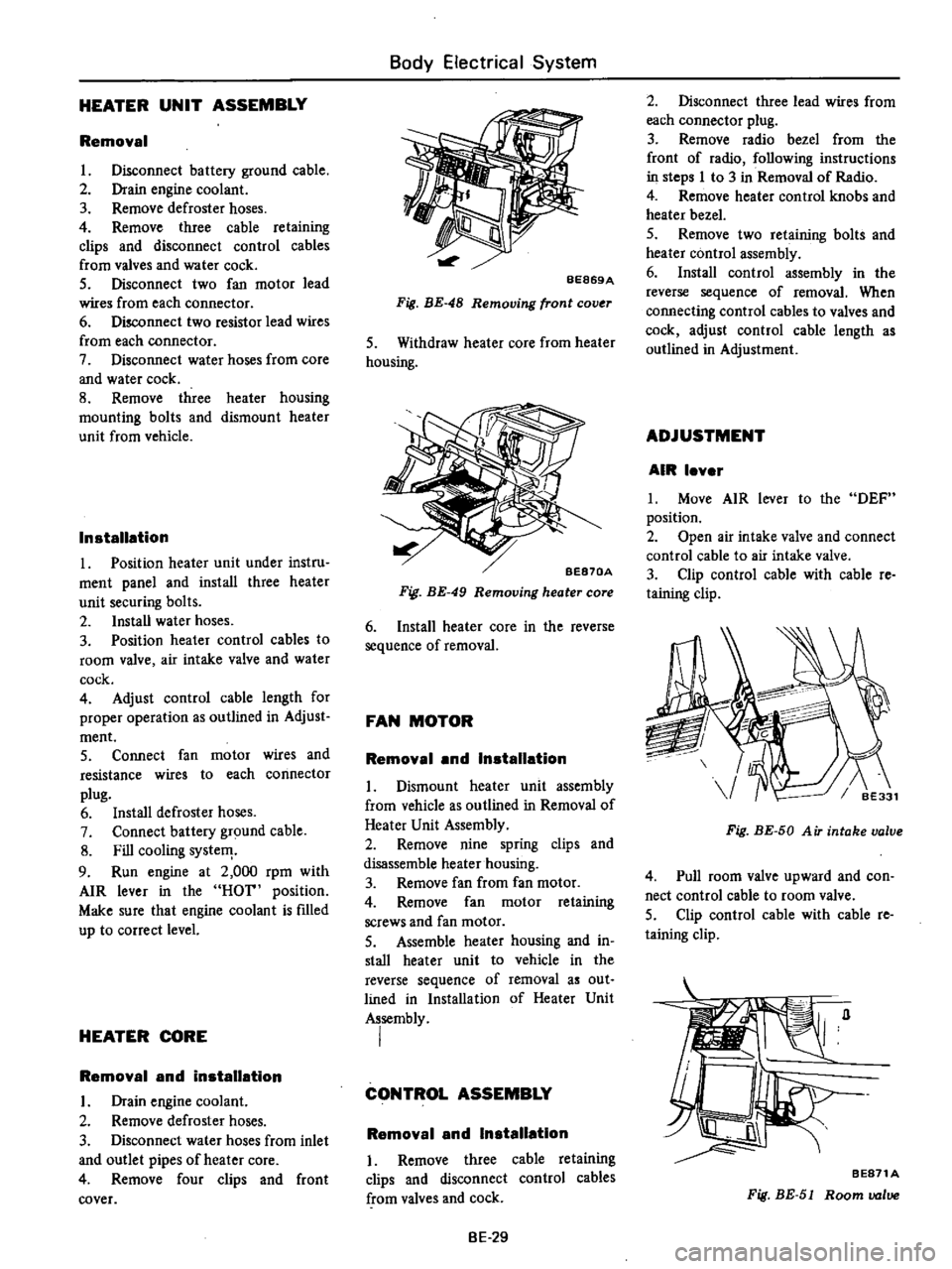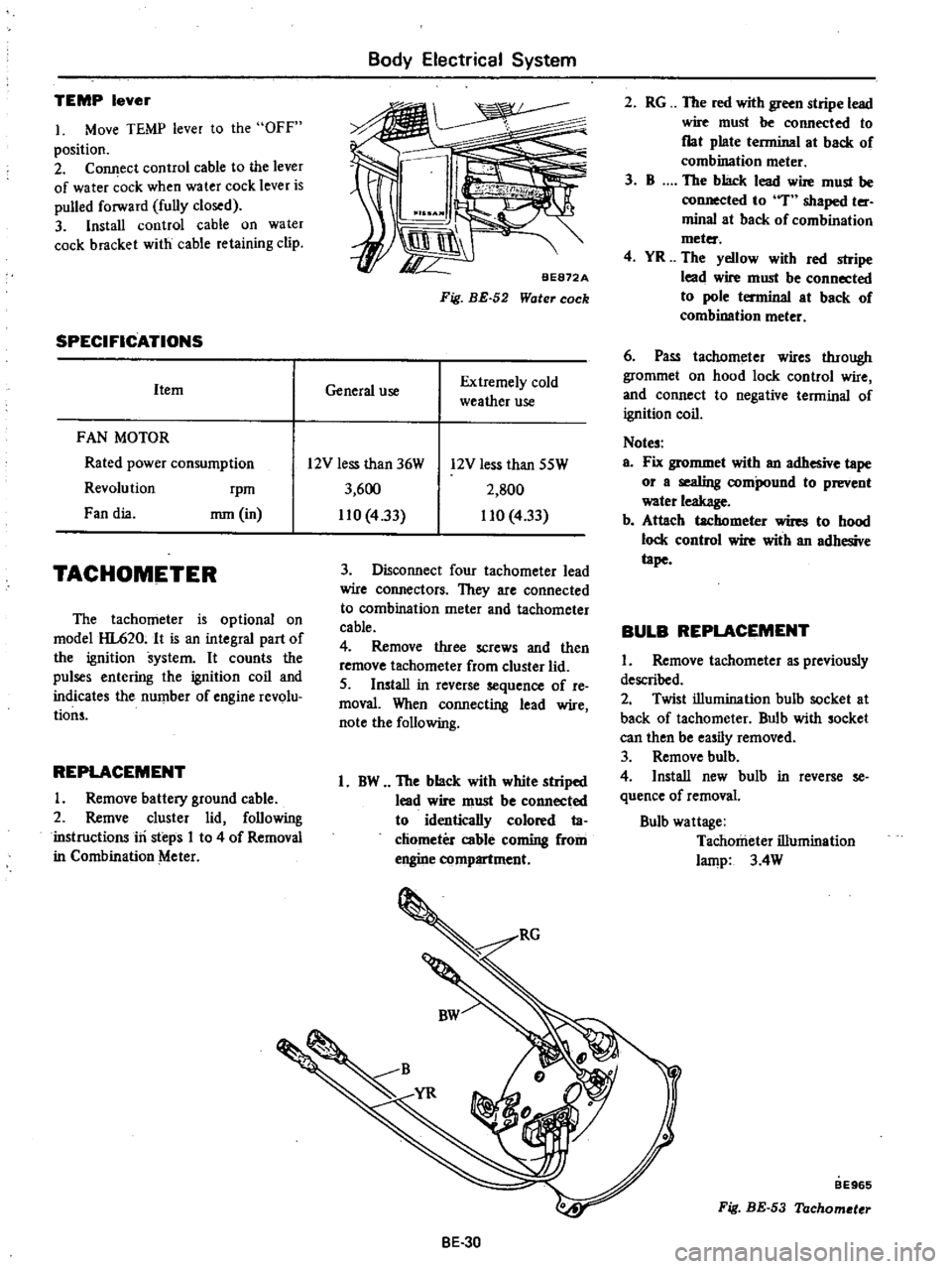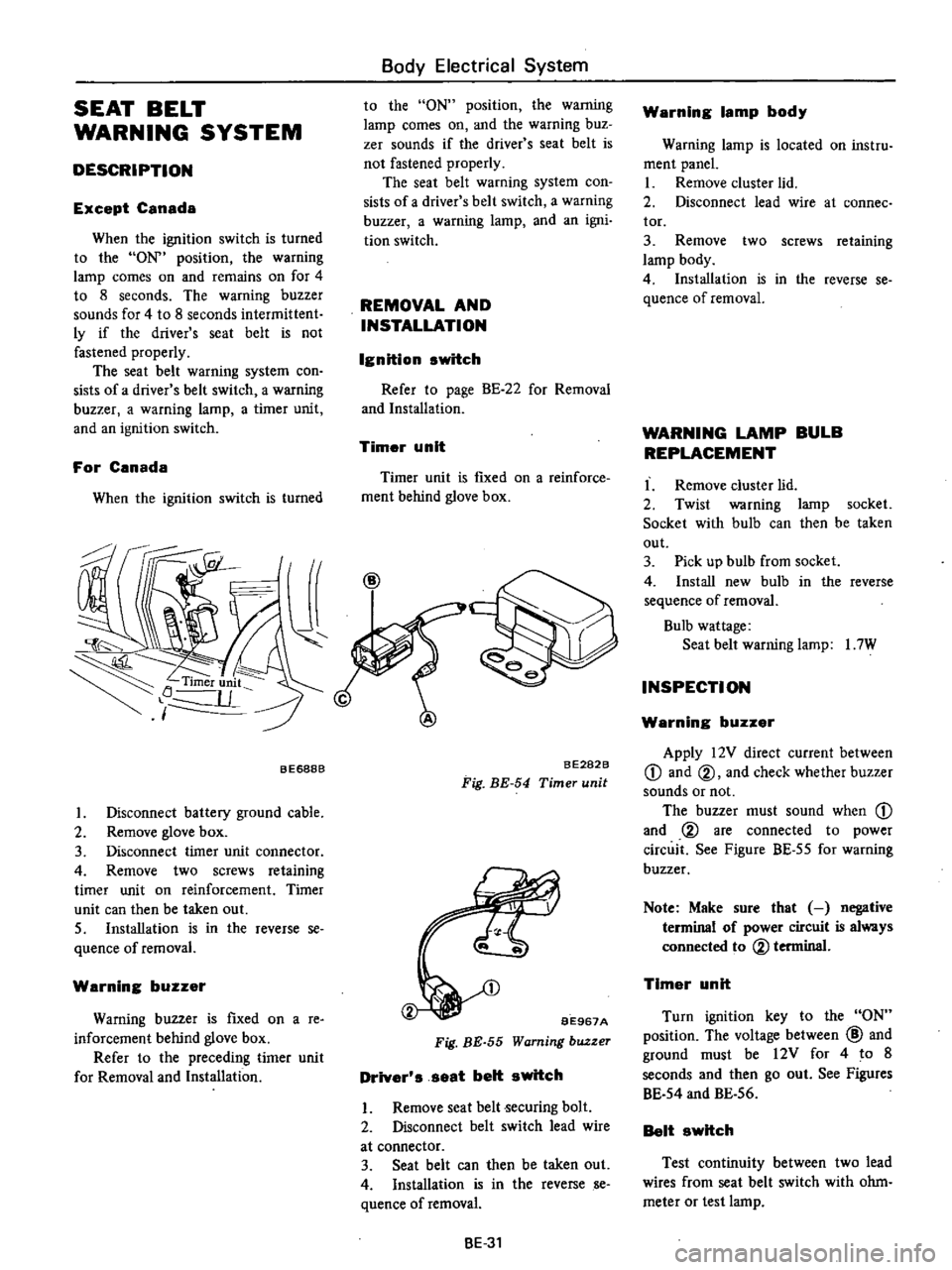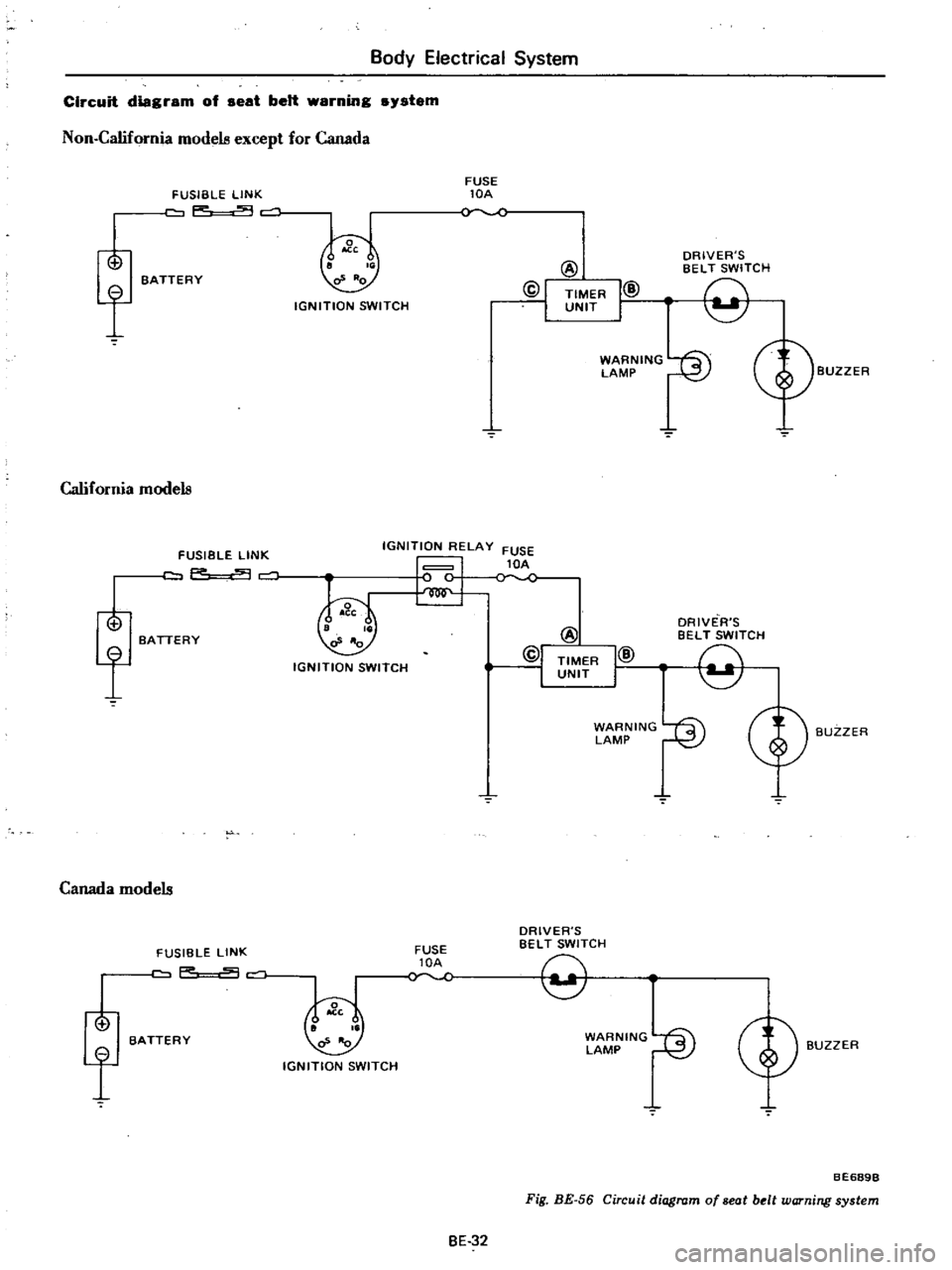battery DATSUN PICK-UP 1977 Repair Manual
[x] Cancel search | Manufacturer: DATSUN, Model Year: 1977, Model line: PICK-UP, Model: DATSUN PICK-UP 1977Pages: 537, PDF Size: 35.48 MB
Page 474 of 537

HEATER
UNIT
ASSEMBLY
Removal
L
Disconnect
battery
ground
cable
2
Drain
engine
coolant
3
Remove
defroster
hoses
4
Remove
three
cable
retaining
clips
and
disconnect
control
cables
from
valves
and
water
cock
5
Disconnect
two
fan
motor
lead
wires
from
each
connector
6
Disconnect
two
resistor
lead
wires
from
each
connector
7
Disconnect
water
hoses
from
core
and
water
cock
8
Remove
three
heater
housing
mounting
bolts
and
dismount
heater
unit
from
vehicle
Installation
1
Position
heater
unit
under
instru
ment
panel
and
install
three
heater
unit
securing
bolts
2
Install
water
hoses
3
Position
heater
control
cables
to
room
valve
air
intake
valve
and
water
cock
4
Adjust
control
cable
length
for
proper
operation
as
outlined
in
Adjust
ment
5
Connect
fan
motor
wires
and
resistance
wires
to
each
connector
plug
6
Install
defroster
hoses
7
Connect
battery
ground
cable
8
Fill
cooling
systeIT
9
Run
engine
at
2
000
rpm
with
AIR
lever
in
the
HOT
position
Make
sure
that
engine
coolant
is
fIlled
up
to
correct
level
HEATER
CORE
Removal
and
installation
L
Drain
engine
coolant
2
Remove
defroster
hoses
3
Disconnect
water
hoses
from
inlet
and
outlet
pipes
of
heater
core
4
Remove
four
clips
and
front
cover
Body
Electrical
System
BE869A
Fig
BE
48
Removing
front
cov
r
S
Withdraw
heater
core
from
heater
housing
BE870A
Fig
BE
49
Removing
heater
core
6
Install
heater
core
in
the
reverse
sequence
of
removal
FAN
MOTOR
Removal
and
Installation
L
Dismount
heater
unit
assembly
from
vehicle
as
outlined
in
Removal
of
Heater
Unit
Assembly
2
Remove
nine
spring
clips
and
disassemble
heater
housing
3
Remove
fan
from
fan
motor
4
Remove
fan
motor
retaining
screws
and
fan
motor
S
Assemble
heater
housing
and
in
stall
heater
unit
to
vehicle
in
the
reverse
sequence
of
removal
as
out
lined
in
Installation
of
Heater
Unit
Assembly
I
CONTROL
ASSEMBLY
Removal
and
Installation
I
Remove
three
cable
retaining
clips
and
disconnect
control
cables
from
valves
and
cock
BE
29
2
Disconnect
three
lead
wires
from
each
connector
plug
3
Remove
radio
bezel
from
the
front
of
radio
following
instructions
in
steps
I
to
3
in
Removal
of
Radio
4
Remove
heater
control
knobs
and
heater
bezel
5
Remove
two
retaining
bolts
and
heater
control
assembly
6
Install
control
assembly
in
the
reverse
sequence
of
removal
When
connecting
control
cables
to
valves
and
cock
adjust
control
cable
length
as
outlined
in
Adjustment
ADJUSTMENT
AIR
lever
L
Move
AIR
lever
to
the
DEF
position
2
Open
air
intake
valve
and
connect
control
cable
to
air
intake
valve
3
Clip
control
cable
with
cable
re
taining
clip
Fig
BE
50
A
iT
intake
valve
4
Pull
room
valve
upward
and
con
nect
control
cable
to
room
valve
5
Clip
control
cable
with
cable
re
taining
clip
BE871A
Fig
BE
51
Room
valve
Page 475 of 537

TEMP
lever
1
Move
TEMP
lever
to
the
OFF
position
2
Connect
control
cable
to
the
lever
of
water
ock
when
water
cock
lever
is
pulled
forward
fully
closed
3
Install
control
cable
on
water
cock
bracket
with
cable
retaining
clip
SPECIFICATIONS
Item
FAN
MOTOR
Rated
power
consumption
Revolution
rpm
Fan
dia
mm
in
TACHOMETER
The
tachometer
is
optional
on
model
HL620
It
is
an
integral
part
of
the
ignition
system
It
counts
the
pulses
entering
the
ignition
coil
and
indicates
the
number
of
engine
revolu
tions
REPLACEMENT
I
Remove
battery
ground
cable
2
Remve
cluster
lid
following
instructions
iri
steps
I
to
4
of
Removal
in
Combination
Meter
Body
Electrical
System
BE872A
Fig
BE
52
Water
cock
General
use
Extremely
cold
weather
use
2
RG
The
red
with
green
stripe
lead
wire
must
be
connected
to
flat
plate
terminal
at
back
of
combination
meter
3
B
The
black
lead
wire
must
be
connected
to
T
shaped
ter
minal
at
back
of
combination
meter
4
YR
The
yellow
with
red
stripe
lead
wire
must
be
connected
to
pole
terminal
at
back
of
combination
meter
6
Pass
tachllmeter
wires
through
grommet
on
hood
lock
control
wire
and
connect
to
negative
terminal
of
ignition
coil
Notes
a
Fix
grommet
with
an
adhesive
tape
or
a
sealing
compound
to
prevent
water
leakage
b
Attach
tachometer
wires
to
hood
lock
control
wire
with
an
adhesive
tape
BULB
REPLACEMENT
I
Remove
tachometer
as
previously
described
2
Twist
illumination
bulh
socket
at
back
of
tachometer
Bulb
with
socket
can
then
be
easily
removed
3
Remove
bulb
4
Install
new
bulb
in
reverse
se
quence
of
removal
Bulb
wattage
Tachometer
illumination
lamp
3
4W
12V
less
than
36W
3
600
110
433
12V
less
than
SSW
2
SOO
110
4
33
3
Disconnect
four
tachometer
lead
wire
connectors
They
are
connected
to
combination
meter
and
tachometer
cable
4
Remove
three
screws
and
then
remove
tachometer
from
cluster
lid
5
Install
in
reverse
sequence
of
re
moval
When
connecting
lead
wire
note
the
following
1
BW
The
black
with
white
striped
lead
wire
must
be
connected
to
identically
colored
ta
chometer
cable
coming
from
engine
compartment
BE
30
BE965
Fig
BE
53
Tachometer
Page 476 of 537

SEAT
BELT
WARNING
SYSTEM
DESCRIPTION
Except
Canada
When
the
ignition
switch
is
turned
to
the
ON
position
the
warning
lamp
comes
on
and
remains
on
for
4
to
8
seconds
The
warning
buzzer
sounds
for
4
to
8
seconds
intermittent
ly
if
the
driver
s
seat
belt
is
not
fastened
properly
The
seat
belt
warning
system
con
sists
of
a
driver
s
belt
switch
a
warning
buzzer
a
warning
lamp
a
timer
unit
and
an
ignition
switch
For
Canada
When
the
ignition
switch
is
turned
Body
Electrical
System
to
the
ON
position
the
warning
lamp
comes
on
and
the
warning
buz
zer
sounds
if
the
driver
s
seat
belt
is
not
fastened
properly
The
seat
belt
warning
system
con
sists
of
a
driver
s
belt
switch
a
warning
buzzer
a
warning
lamp
and
an
igni
tion
switch
REMOVAL
AND
INSTALLATION
Ignition
switch
Refer
to
page
BE
22
for
Removal
and
Installation
Timer
unit
Timer
unit
is
fIXed
on
a
reinforce
ment
behind
glove
box
BE688B
I
Disconnect
battery
ground
cable
2
Remove
glove
box
3
Disconnect
timer
unit
connector
4
Remove
two
screws
retaining
timer
unit
on
reinforcement
Timer
unit
can
then
be
taken
out
S
Installation
is
in
the
reverse
se
quence
of
removal
Warning
buzzer
Warning
buzzer
is
fIxed
on
a
re
inforcement
behind
glove
box
Refer
to
the
preceding
timer
unit
for
Removal
and
Installation
BE282B
Fig
BE
54
Timer
unit
BE967A
Fig
BE
55
Warning
buzzer
Driver
s
seat
belt
switch
I
Remove
seat
belt
ecuring
bolt
2
Disconnect
belt
switch
lead
wire
at
connector
3
Seat
belt
can
then
be
taken
out
4
Installation
is
in
the
reverse
se
quence
ofremoval
BE
31
Warning
lamp
body
Warning
lamp
is
located
on
instru
ment
panel
I
Remove
cluster
lid
2
Disconnect
lead
wire
at
connee
tor
3
Remove
two
screws
retaining
lamp
body
4
Installation
is
in
the
reverse
se
quence
of
removal
WARNING
LAMP
BULB
REPLACEMENT
I
Remove
cluster
lid
2
Twist
warning
lamp
socket
Socket
with
bulb
can
then
be
taken
out
3
Pick
up
bulb
from
socket
4
Install
new
bulb
in
the
reverse
sequence
of
removal
Bulb
wattage
Seat
belt
warning
lamp
I
7W
INSPECTION
Warning
buzzer
Apply
12V
direct
current
between
CD
and
@
and
check
whether
buzzer
sounds
or
not
The
buzzer
must
sound
when
CD
and
@
are
connected
to
power
circuit
See
Figure
BE
55
for
warning
buzzer
Note
Make
sure
that
negative
terminal
of
power
circuit
is
always
connected
to
@
terminal
Timer
unit
Turn
ignition
key
to
the
ON
position
The
voltage
between
@
and
ground
must
be
12V
for
4
to
8
seconds
and
then
go
out
See
Figures
BE
54
and
BE
56
Belt
switch
Test
continuity
between
two
lead
wires
from
seat
belt
switch
with
ohm
meter
or
test
lamp
Page 477 of 537

Body
Electrical
System
Circuit
diagram
of
seat
belt
warning
system
Non
California
modela
except
for
Canada
f
FUSIBLE
LINK
p
c
o
BATTERY
California
modela
f
Canada
modela
o
f
FUSIBLE
LINK
F
9
BATTERY
FUSIBLE
LINK
aP
c
BATTERY
IGNITION
SWITCH
FUSE
lOA
@
@I
TIMER
UNIT
I@
I
WARNING
fS
LAMP
l
2
IGNITION
RELAY
FUSE
1
lC
1
lOA
IGNITION
SWITCH
N
IGN
ITION
SWITCH
FUSE
lOA
BE
32
DRIVER
S
BELT
SWITCH
9
ORIVE
R
S
BELT
SWITCH
9
WARNING
r
i
LAMP
I
2
J
DRIVER
S
BELT
SWITCH
9
WARNING
fS
LAMP
I
2
J
Cf
BUZZER
BUZZER
BUZZER
BE689B
Fig
BE
56
Circuit
diagram
of
seat
belt
warning
system
Page 478 of 537

Body
Electrical
System
TROUBLE
DIAGNOSES
AND
CORRECTIONS
HORN
Condition
Horn
does
not
operate
Horn
sounds
continuously
Reduced
volume
and
or
tone
quality
Probable
cause
Discharged
battery
Measure
specific
gravity
of
electrolyte
Burnt
fuse
Faulty
horn
button
contact
Horn
sounds
when
horn
relay
terminal
s
is
grounded
Inoperative
horn
relay
Horn
sounds
when
B
and
H
horn
relay
tenninals
are
connected
with
a
test
lead
Damaged
horn
or
loose
horn
terminal
con
nection
Short
circuited
horn
button
and
or
horn
button
lead
wire
When
light
green
lead
wire
is
disconnected
from
horn
relay
terminal
s
horn
stops
to
sound
Inoperative
horn
relay
Loose
or
poor
connector
contact
Fuse
relay
horn
and
or
horn
button
Damaged
horn
BE
33
Corrective
action
Recharge
or
replace
battery
Correct
cause
and
replace
fuse
Repair
horn
button
Replace
horn
relay
Correct
horn
te
inal
onnection
or
replace
horn
Repair
horn
button
or
its
wiring
Replace
horn
relay
Repair
Replace
Page 481 of 537

CD
m
Cl
@
D
@
I
j
1
To
instrument
harness
IS
To
battery
30
To
check
connector
2
To
full
transistor
amplifier
16
To
fusible
link
3t
To
headlamp
L
U
type
2
California
models
only
17
To
engine
harness
No
2
32
To
sido
marker
lamp
L
B
3
To
hood
switch
18
To
alternator
33
To
front
combination
lamp
L
H
4
To
engine
compartment
lamp
1
9
To
front
combination
lamp
R
n
34
To
horn
Low
ll
l
S
To
washer
motor
20
To
headlamp
R
H
type
2
3S
To
horn
High
l
l
0
6
To
auto
choke
heater
relay
1
To
side
marker
lamp
R
n
36
To
B
C
D
D
cut
olenoid
California
models
7
To
detector
dri
e
counter
22
To
headlamp
R
B
type
1
only
Non
Califunia
model
except
for
Canada
23
To
ground
37
To
block
tcrminal
distributor
California
8
To
ignition
relay
California
models
only
i4
To
thermal
transmitter
models
only
9
To
floor
sensor
relay
California
modeb
only
is
To
distributor
Non
California
models
only
38
To
ignition
coil
Non
California
models
only
n
10
To
inhibitor
relay
A
T
only
26
To
8
C
D
D
cut
solenoid
Non
California
39
To
condenser
t
II
To
head
lamp
relay
models
only
40
To
ignition
coil
and
resistor
@
12
To
horn
relay
27
To
fuel
cut
solenoid
California
models
only
OJ
v
m
13
To
voltage
regulator
28
To
auto
choke
heater
g
e
14
To
cooler
cable
29
To
headlamp
L
R
type
1
OJ
to
o
Q
m
r0
C
1
i
Ql
CIl
Il
l
3
Page 483 of 537

m
ii
bl
l
l
l
if
3
i
m
1
Kickdown
solenoid
AlT
2
Oip
3
Inhibitor
switch
AfT
4
Oip
5
Engine
6
Battery
cable
7
Engine
slinger
8
Battery
cable
r
0
w
I
I
cf
n
L
J
TO
ENGtNE
ROOM
HARNESS
OJ
o
Q
m
O
Q
CIl
II
D
3
Page 488 of 537

Body
Electrical
System
EMISSION
WARNING
SYSTEM
California
models
CONTENTS
FLOOR
TEMPERATURE
WARNING
SYSTEM
California
models
DESCRIPTION
FLOOR
TEMPERATURE
WARNING
SYSTEM
California
models
DESCRIPTION
The
floor
temperature
warning
system
consists
of
a
floor
temperature
sensing
switch
installed
on
the
vehicle
floor
a
floor
temperature
relay
a
floor
temperature
warning
lamp
and
harnesses
When
the
floor
temperature
rises
to
an
abnormal
level
the
warning
lamp
will
come
on
to
call
the
attention
of
the
driver
i
f
FUSIBLE
LINK
P
BATTERY
IGNITION
SWITCH
BE
43
8E
43
WARNING
LAMP
TROUBLE
SHOOTING
GUIDE
BE
43
BE
44
The
warning
lamp
also
comes
on
during
operation
of
the
starter
motor
permitting
inspection
of
the
lamp
s
condition
The
lamp
goes
out
after
the
engine
starts
Refer
to
Section
EC
for
details
WARNING
LAMP
Bulb
replacement
I
Remove
cluster
lid
2
Twist
warni
ng
lamp
socket
Socket
with
bulb
can
then
be
taken
out
3
Pick
up
bulb
from
socket
IGNITION
RELAY
I
I
4
Installation
is
in
the
reverse
se
quence
of
removaL
Bulb
wattage
Floor
temperature
warning
lamp
17W
Lamp
body
replacement
I
Remove
cluster
lld
2
Disconnect
lead
wire
at
connee
tor
3
Remove
two
screws
retaining
lamp
body
4
Installation
is
in
the
reverse
se
quence
of
removal
FLOOR
I
l
I
SENSOR
RELAY
WARNING
I
LAMP
FLOOR
SENSOR
ON
FLOOR
TEMPERATURE
LOW
OFF
FLOOR
TEMPERATURE
HIGH
7
BE697B
Fig
BE
64
Circuit
diagram
of
floor
temperature
warning
system
BE
43
Page 494 of 537

The
refrigerant
within
the
thermo
bulb
changes
in
pressure
through
the
super
heat
condition
of
vaporized
re
frigerant
gas
which
comes
out
of
the
evaporator
causing
the
deflection
of
the
diaphragm
The
lift
of
the
ball
valve
attached
to
the
diaphragm
is
changed
by
the
deflection
of
the
dia
phragm
thus
controlling
the
amount
of
refrigerant
passing
the
orifice
ELECTRICAL
CIRCUIT
DESCRIPTION
The
electrical
circuit
of
the
air
conditioner
consists
of
four
switches
two
relays
a
solenoid
valve
a
fan
motor
and
a
compressor
magnetic
clutch
Air
Conditioning
Diaphragm
Orifice
Valve
ball
AC729
4
Sensing
bulb
Fig
A
C
6
Expansion
value
The
following
wiring
diagram
pro
vides
a
complete
description
of
the
whole
circuit
When
the
ignition
switch
and
the
fan
switch
are
ON
the
main
relay
is
activated
causing
battery
power
to
flow
through
the
fan
motor
and
the
magnetic
clutch
The
magnetic
clutch
is
activated
by
the
thermo
switch
AC
5
000
l
1
Motor
2
Fan
3
Lower
case
4
Cooler
duct
5
Evaporator
6
Expansion
valve
7
Upper
case
8
Resistor
9
Main
relay
10
Thermo
switch
II
Cable
clamp
12
Cable
13
Harness
AC725
Fig
AC
7
Cooling
unit
pressure
switch
and
compressor
relay
The
blower
motor
fan
speed
is
con
trolled
by
the
fan
switch
and
resistor
The
solenoid
valve
is
also
activated
This
in
turn
causes
the
fast
idle
control
device
F
l
C
D
to
increase
engine
speed
when
the
vehicle
is
at
rest
with
the
engine
ON
Page 496 of 537

MAIN
RELAY
The
main
relay
is
located
on
the
cooling
unit
When
the
ignition
switch
and
fan
switch
are
both
turned
on
the
COll
@
FAN
SWITCH
The
fan
switch
serving
as
a
control
unit
is
installed
on
the
center
console
This
switch
controls
the
blower
motor
speed
through
the
resistor
It
is
also
used
as
a
main
relay
switch
Fig
AC
I0
Fan
switch
THERMO
SWITCH
The
thermo
switch
is
located
on
the
upper
side
of
the
cooling
unit
and
is
controlled
by
the
cable
and
the
con
trollever
attached
to
the
console
box
It
is
so
designed
that
when
the
air
passing
through
the
evaporator
core
is
cooled
down
to
the
predetermined
Air
Conditioning
tacts
in
the
relay
are
closed
Then
electrical
power
from
the
battery
is
supplied
to
the
blower
motor
and
the
electrical
clutch
for
the
compressor
@
Dc
IDe
ID
1
1
l@
@
e
L
J
AC465
Fig
A
C
9
Main
relay
temperature
set
by
the
control
lever
it
automatically
turns
off
When
the
switch
is
turned
off
the
magnetic
clutch
is
turned
off
stopping
the
flow
of
refrigerant
inside
the
cooling
system
and
increasing
the
cooling
system
tem
perature
When
the
air
rises
to
the
pre
determined
temperature
the
thermo
switch
automatically
turns
on
In
this
way
the
temperature
of
the
air
dis
charged
from
the
cooling
unit
is
auto
matically
controlled
as
desired
PRESSURE
SWITCH
The
pressure
switch
is
turned
off
when
refrigerant
pressure
in
the
cooling
system
rises
to
an
abnormally
high
level
28
kg
cm2
398
psi
This
in
turn
turns
off
the
compressor
magnetic
clutch
actuating
the
com
pressor
relay
and
gradually
decreasing
pressure
in
the
cooling
system
When
the
pressure
drops
to
or
below
24
kg
cm2
341
psi
the
pressure
switch
again
turns
on
Thus
cooling
system
refrigerant
pressure
is
automatically
maintained
at
the
proper
value
a
t
all
times
AC
7
COMPRESSOR
RERAY
The
compressor
relay
is
attached
to
the
receiver
dryer
bracket
on
the
right
side
of
the
engine
compartment
This
relay
is
actuated
by
the
fan
switch
thermo
switch
and
pressure
switch
to
turn
on
and
off
the
compressor
magnetic
clutch
cv
1
2
AC731
Fig
A
C
11
Pressure
switch
and
compressor
relay
F
I
C
D
SOLENOID
VALVE
The
F
l
C
D
solenoid
valve
is
at
tached
to
the
dash
panel
in
the
engine
compartment
This
valve
supplies
vacu
um
to
the
F
I
C
D
diaphragm
through
the
vacuum
hose
connected
to
the
engine
intake
manifold
when
the
engine
is
at
idle
and
the
cooling
system
is
ON
thereby
raising
idle
speed
to
the
predetermined
rpm
800
IW
r
e
I
1
s
AC132
Fig
AC
12
F
l
C
D
solenoid
value